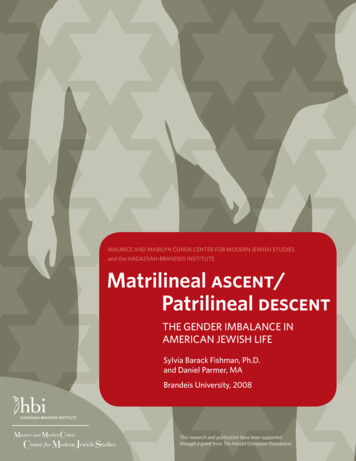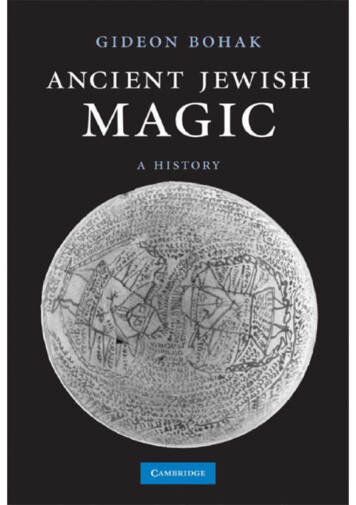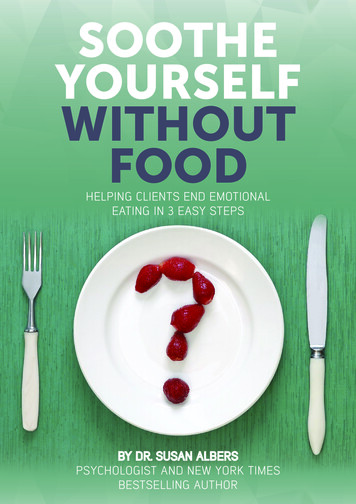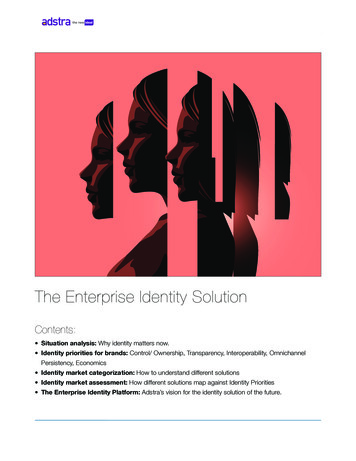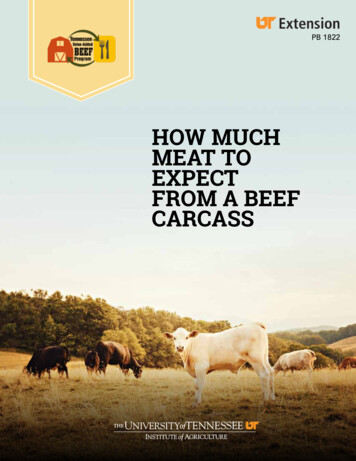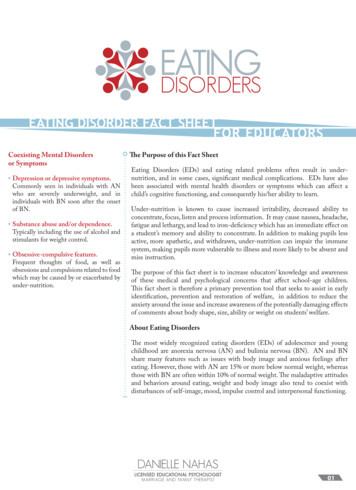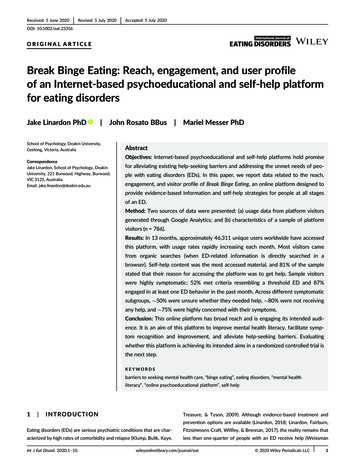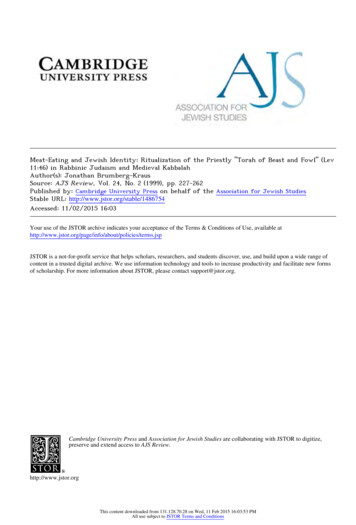
Transcription
Meat-Eating and Jewish Identity: Ritualization of the Priestly "Torah of Beast and Fowl" (Lev11:46) in Rabbinic Judaism and Medieval KabbalahAuthor(s): Jonathan Brumberg-KrausSource: AJS Review, Vol. 24, No. 2 (1999), pp. 227-262Published by: Cambridge University Press on behalf of the Association for Jewish StudiesStable URL: http://www.jstor.org/stable/1486754 .Accessed: 11/02/2015 16:03Your use of the JSTOR archive indicates your acceptance of the Terms & Conditions of Use, available at ms.jsp.JSTOR is a not-for-profit service that helps scholars, researchers, and students discover, use, and build upon a wide range ofcontent in a trusted digital archive. We use information technology and tools to increase productivity and facilitate new formsof scholarship. For more information about JSTOR, please contact support@jstor.org.Cambridge University Press and Association for Jewish Studies are collaborating with JSTOR to digitize,preserve and extend access to AJS Review.http://www.jstor.orgThis content downloaded from 131.128.70.28 on Wed, 11 Feb 2015 16:03:53 PMAll use subject to JSTOR Terms and Conditions
AND JEWISHIDENTITY:MEAT-EATINGOF THEPRIESTLY"TORAHRITUALIZATIONOF BEASTAND FOWL"(LEV 11:46)IN RABBINICJUDAISMAND MEDIEVALKABBALAHbyJONATHANBRUMBERG-KRAUSIn a fascinatingchapterdealingwith the "natureof eating"in Shulhanshel Arba, a short thirteenth-centurymanualon rabbiniceating rituals,R.Bahyab. Asher suggeststhatTorahscholarsalone arefit to eat meat,basedon the followingpassagefromthe Talmud:"it is forbiddenfor an ignoramus[am ha-aretz]to eat meat, as it is written,'This is the torahof beast andfowl' (Lev 11:46);for all who engage in Torah,it is permittedto eat theflesh of beast and fowl. But for all who do not engage in Torah,it isnot permittedto eat beast and fowl."' This passageraises many questions,especiallyfor a vegetarian!First,why wouldan intellectualor spiritualeliteuse meat-eatingas a way to distinguishitself from the masses?The fieldof comparativereligionsoffersmanycounter-examplesto this Neoplatonistregimenadvocatedby Porphyryin malrightsactivists,andfeministvegetarianslike CarolAdams.2Moreover,the mind/bodydualism1. b.Pesah49b, quotedby Bahya, Shulhanshel Arba, from Kitve RabenuBahya (Kadha-kemah,Shulhanshel Arba,PirkeAvot),ed. CharlesB. Chavel(Jerusalem:MossadHaravKook, 1969),p. 496.2. See Colin Spencer,TheHeretics Feast: A Historyof Vegetarianism(Hanover,N.H.:UniversityPress of New England,1995); CarolJ. Adams, The SexualPolitics of Meat: AFeministVegetarianCriticalTheory(New York:Continuum,1990).AJSReview24/2 (1999):227-262This content downloaded from 131.128.70.28 on Wed, 11 Feb 2015 16:03:53 PMAll use subject to JSTOR Terms and Conditions227
228JONATHANBRUMBERG-KRAUSof Westernphilosophicaland religious traditionsof asceticism tends toreinforcethe idea that vegetarianismand fasting are closer to the idealof intellectualperfectionthan slavery to our so-called animalcravingstoeat flesh. Giving up meat for Lent or sustainingoneself miraculouslyonthe breadand wine of the eucharisticelements,as is reportedaboutsomemedieval female mystics, reflectsthis tendencyin the Christiantradition,though vegetariantraditionsare relativelyrare in Judaism.3On the otherhand,the medievalsourcescomposedby the circleof late-thirteenth-centurySpanishkabbaliststhat we are about to discuss acknowledgethat at firstview the Torah'scommandmentsto eat meat are problematic,and demandan ggeststhatkillinganimalsfor food seems to contradictGod'sjustice.4Bahyahimselfpointsout3. On attitudestowardvegetarianismin the early Christianchurch,see Diane Bazell,"StrifeAmong the Table-Fellows:ConflictingAttitudesof Early and MedievalChristiansTowardEatingMeat,"Journalof theAmericanAcademyof Religion65 (1997):73-99. Bazellinfluencesof Greekpointsout a basic tensionin earlyChristianitybetweenthe pro-vegetarianaboutone's diet,philosophicalasceticismand the nonvegetarianimpulseto be indiscriminatei.e., have no qualmsabout eating nonkoshermeat, or meat sacrificedto idols, in ordertodistinguishChristianityfrom Judaism(p. 85). See also VeronikaGrimm,FromFeasting toFasting, the Evolutionof a Sin: Attitudesto Food in Late Antiquity(New York:Routledge,1996), pp. 103-105. On the medievalaccountsof miraculoussustenanceon the elementsofcommunion,see CarolWalkerBynum,HolyFeast andHolyFast: TheReligiousSignificanceofFood toMedievalWomen(Berkeley:Universityof CaliforniaPress,1987),esp.pp. ti-vegetariantendency,see Grimm,FromFeastingto Fasting, pp. 16-17, 27. Vegetarianismhas experienceda revivalamongtwentieth-centuryJews, for example,Rav AbrahamIsaac Kook, the first chief rabbiof Israel,IsaacBashevisSinger,and RabbiArthurGreen;and there is a Jewish VegetarianSociety that publishesaPassoverHaggadahfor a meatlessseder, TheHaggadahof the LiberatedLamb.While forRav Kook and I. B. Singer,vegetarianismwas a privatediscipline,Green,in SeekMy Face,Jewish Theology(Northvale,N.J.: J. Aronson,1992), pp.SpeakMy Name:A Contemporary87-89, and the Jewish VegetarianSociety advocatevegetarianismas a normfor otherJews.animalrightsand ecologicalawareness,they root theirThoughinfluencedby swe aregoingto discussbelow.Seevegetarianismalso Art Waskow,Down to EarthJudaism:Food, Money,Sex and theRestof Life(New York:WilliamMorrow,1995),pp. 135-136.4. Joseph Gikatilla,Shaare Orah, ed. Joseph Ben Shlomo (Jerusalem:Mossad Bialik,1981),II, 11-12:And now I havea greatkey to openthis matter.Whatdidthe Lord(mayHe be blessed)see to commandin the Torahthe slaughterof animalsfor humanbeingsto eat?For isit not written,"TheLordis good to all, and His mercyextendsto all His works"[Ps145:9]?And if He acts mercifully,why did He commandthatbeastsbe slaughteredforhumanbeingsto eat;whereis the mercyin that?But the secretis in thebeginningof theThis content downloaded from 131.128.70.28 on Wed, 11 Feb 2015 16:03:53 PMAll use subject to JSTOR Terms and Conditions
ANDJEWISHIDENTITYMEAT-EATING229is siresinourfallenstate;AdamandEve didnot eatmeatin Eden.5Andin theworld-to-come,will feastonlyon "litefood,"i.e., he "torahof beastfoodscreatedfromthe supernallight."6verse, which said, "theLordis good to all,"good in fact, andaccordingly"Hismercyextendsto all his works."Duringtheworkof creation,anagreementwasreachedwiththecowto be slaughtered,and she said, "Good."And whatwas her reason?Since the cow had no highersoul toconceiveof the workof HaShemandHis powers,the Lord(mayHe be blessed),whenHe was creatingthe world,told all the beaststo standbeforeHim,andHe said,"Ifyouconsentto be slaughtered,andto havehumanbeingseat you, thenyou will ascendfromthe statusof a beastthatknowsnothingto the statusof a humanbeingwho knowsandrecognizesthe Lord(may He be blessed)."And the beastsreplied,"Good.His merciesare on us." Whenevera humanbeing eats a portionof the portionsof a beast,it turnsinto a portionof the humanbeing.Herethe beastis transformedintoa person,andherslaughteris an act of mercy,for she leaves the torahof beastsandentersintothe torahof humanbeings.Deathis life for it, in thatit ascendsto the degreeof angels-and thisis the secretof "Manandbeastthe Lordwill save"[Ps 36:8].If you really reflecton the secret of slaughteringanimals,then everythingcomesfromthe side of His mercyandlove forall His creatures.And thusreflecton the reasonwhy ourrabbissaidin tractatePesahimof theTalmud,"Itis forbiddenforan amha-aretzto eat meat."For it was not commandedin the Torahto slaughtera beastunless oneknows the "torahof beasts, wild animals,and fowl."And whoeverengages in Torahis permittedto eat meat. Thus an am ha-aretzdoes not eat meatbecausehe is like abeastwithouta soul, andhe is not commandedto slaughtera beastonly so thatanother"beast"can eat it, but rather,if so, it [the beast] becomeslike carrionand prey [i.e.,forbidden,of a lower,"unfit"status].5. Bahya,Shulhanshel Arba, p. 496: "Considerwell thathumanbeings' food oughttohave been only plantsfromthe earth,such as grainproduceand fruit,not animals. but atthe time when all flesh ruinedits way and all animalsdeservedannihilation,they were savedonly by the meritof Noah, to whom animalswere thempermitted[to be eaten]just like thegreengrasses"(an allusionto Gen 9:3: "Everyliving creatureshallbe yoursfor food, like thegreengrasses,I am now giving you everything").Bahyahas a very clearlyarticulatedsense ofa fall of humanityin Eden,even if it soundsalmostlike Christianoriginalsin. He refersto therabbinictraditionsof Adam'sloss of stature,and describesthe post-Edenichumanconditionthus,"allthe childrenof Adam,the childrenof the manof sin, we areall stained,andoursoulsickened [gam benei 'adam gam benei 'ish 'avon kulanu nikhtam ve-nafshenu davah ]," p. 459.6. Bahya, Shulhan shel Arba, p. 501 (ha-ma 'akhlimha-dakim ve-ha-zakhimshenivre 'u minha- 'orha- 'elyon).I owe this metaphorto AndreaLieber,whose aptlytitledunpublishedpaper,"TastesGreat,Less Filling,"deals in detailwith Jewishandparalleltraditionsof nourishmentthroughthe sense of sight.This content downloaded from 131.128.70.28 on Wed, 11 Feb 2015 16:03:53 PMAll use subject to JSTOR Terms and Conditions
230JONATHANBRUMBERG-KRAUSand fowl" baraitafromthe Talmudto justify Judaism'sslaughterof animalsfor food.Second, why does engagementin Torahper se qualify someoneto killanimalsto eat their meat? Perhapsit is the way for Jews to assert theirdistinctivegroup identityvis-a-vis non-Jews.The possession of the Torahrevealedto Moses at MountSinaiis whatdistinguishesJews fromnon-Jews,and theirobservanceof the Jewishdietarylaws regardingfit andunfitmeatis the visible, publicembodimentof this distinctively"Jewish"Torah.Bahyaoffers this argument,suggestingthat the Torahis a sort of "regimenof thepleasures"(dat sha'ashu'im),a remedyfor Adam'ssin thatthe Jews alonepossess.7However, we are distinguished by our regimen of thepleasures from the nationswhoerr,rebelandsin. Forwe foundourRockin the desertin the landof souls,andthereHe set forus a d,"Setbeforeme a icizesagainstthosewho eat withoutanythought,as mindlesslyas animals.It is well knownof the majorityof the childrenof htheblood,theyspillbloodthemselves.7. The expressiondat sha'ashu'imis difficultto translate,thoughChavel in his notesto Shulhanshel Arba, p. 459, understandsit as an allusionto Ps. 119:92 (lulei toratekhasha 'ashu'iy,"Wouldthatyourtorahwere my pleasure")andmeansthe "Torahwhichis calleddat as a synonymfor the Torah.But'pleasure."'I agreewith ChavelthatBahyaunderstandsBahyadrawson dat'sotherspecificconnotations:law,rule,or decree.I suspectthatBahyahasin mindan analogyto a monasticrule,or manual,for the moralinstructionsfor princesof thetypethatbeganto proliferatein medievalEurope,orto theadabmanualsof etiquettein Muslimculture.Bahyaviews the Torahas a kindof manualof conduct,a seferha-hanhagah,whichhasclearaffinitiesto this genreof ethicalliterature.In otherwords,he projectsthe genreof his ownShulhanshel Arbaonto the Torah.For a discussionof this genreand its relationshipto othermedievalChristianandMuslimethicalmanuals,see Ze'ev asideR. Yisra'el Ba 'al Shem-Tov(Tel Aviv: MossadBialik, 1989), pp.4-11, esp. 5-8. See alsothediscussionof medievalMuslimcookingandtableetiquetteliteraturein JackGoody,Cooking,Cuisine,and Class:A Studyin ,1982),pp. 127-133. ThoughGoodydoes not discussJewishliterature,his point that literaryelaborationsof cooking and table mannerslegitimateupperclasses isrelevantto ourdiscussionof diet andclass distinctionbetweenthe talmideihakhamimandtheammeiha-aretz.This content downloaded from 131.128.70.28 on Wed, 11 Feb 2015 16:03:53 PMAll use subject to JSTOR Terms and Conditions
ANDJEWISHIDENTITYMEAT-EATING231Likean ox eatingstrawtheyeat theirbread,andtheirsoulsarewastedandfull of thewineof lustandemptyof thewineof tthem,hardin pursuitof tangiblepleasures,farfromthewayof truth.Howmanyarethosewhoservetheirsenses,to fulfilltheirdesire,who gatherto draintheircupsto pleasetheirgullet!Andhowfew aretheelitewhoeatto sustaintheirbodyfortheirCreator'ssake!Therethe itthegoodof theworldintotheirvessels;thelightof ointwhentheyeatattheirtables,if theydrinkfromtheirbowl.Butuniqueis theonewhofearsanddelightsintheLordevenovera dinnerof vegetables.8However,it is not so clearherethatBahyameansthatonlynon-Jewslack"theway of truth,"i.e., the Torah.If the expressions"childrenof Adam"and"theyeat with blood"implynon-Jews,the otherphrases:"likean ox eatingstraw,"souls "wastedanddevastated,""drunkenexcess turnsagainstthem,""witlessandignorant,the shiftyman"areall allusionsto scripturalpassagescriticalofIsraeliteswho strayfromthe Lordin pursuitof sensuality.'Moreover,whilethe use of the intellectdistinguishesthe elite fromthe witless in this passage,meat-eatingdoes not. Thosewho "eatwith the blood"aremeat-eaters,whilethe uniqueone "whofearsanddelightsin the Lord"does so even overa mealof vegetables!So Bahya must have in mind more than self-differentiationfrom Gentileswhen he cites the baraitaon the "torahof beast and fowl."Bahya assertsan internaldistinctionbetweenJews who eat mindfully(the"elite"benei 'aliyah)and those who do not, who in his interpretationofthe baraitaare labeled"disciplesof the sages"and sraisesotherquestions.WhyshouldR. Bahyadrawforhis thirteenthcenturyaudiencean anachronisticdistinctionbetween talmideihakhamimandammeiha-aretz? These labelsderivefroma specificsocial situation,therabbinicperiodof JabnehandUsha,afterthe destructionof the Templein 70,in the secondandthirdcenturiesC.E.10Noris thehistoryanddefinitionof these8. Bahya,Shulhanshel Arba,p. 460.9. Chavel,Shulhanshel Arba,p. 460, in his notes suggeststhatBahyaalludeshereto Is11:7,Na 2:11, Hos 4:18, Ezek45:20, Prv 15:28.The'AmHa-aretz:A Studyin theSocialHistoryof theJewish10. As AharonOppenheimer,Period (Leiden:E. J. Brill, 1977),p. 175, suggestsregardingPeople in theHellenistic-Romanthe traditionin its earliercontextas a baraitain b.Pesah49b.This content downloaded from 131.128.70.28 on Wed, 11 Feb 2015 16:03:53 PMAll use subject to JSTOR Terms and Conditions
232JONATHANBRUMBERG-KRAUShakhamimdistinctionin b.Pesah.termssimple.The ammeiha-aretz/talmidei49b's baraitaon Lev. 11:46 representsa shift of terminologyfrom earliertannaitictraditionsaboutthe haverim("colleagues")vs. the ammeiha-aretztannaitictraditionsof(lit., "peoplesof the land").In the earlier,pre-Yavneanor "trustworthythe ciplesof sages"),ofofwere the self-designations members voluntaryassociationsprimarilycomposedof non-priestswho were scrupulousaboutpriestlytithesand theconditionsof purity in which they preparedtheir food. They called Jewswho did not follow theirrules ammeiha-aretz.The haverimwere probablythe Phariseesof the New Testamentand Josephus,who soughtto heightenJewishnationalidentityunderRomanruleby intensifyingthenormsof Jewishbehavior.In particularthey adaptedthe priestlystandardsof purity,andtithedfood for nonpriests,to encourage"lay"Israelitesto participatein theirtablefellowshippractices,as if they were priests.In otherwords,the fellowshipwerea strategyof ritualized"streettheater"practicesof the haverim/Phariseesintendedto win Jewish convertsto theirway of practice."In contrast,wehave later traditionsopposing the hakhahimor talmideihakhamimto theammeiha-aretzthatstressthe former'scommitmentto Torahstudyin the BetMidrashto the latter'signoranceand neglect of it.12 The baraitacontainingour traditionin b.Pesah 49b belongs to this stage in the development.Ifthe pre-70 haverim/Phariseeswere membersof associationsthat gatheredfor table fellowship following priestlike standardsof ritual observance,the post-70 talmidei hakhamimgatheredin associationsfor the study ofTorah.'3Consequently,the definitionof theiropponents,the ammeiha-aretz,changedfrom those who did not observepriestliketable-fellowshiprulesto those who did not study Torah.Whenmodem scholarsaptly distinguishthese two types of am ha-aretzas ammeiha-aretzle-mitzvot("withrespectto the commandments")and ammei ha-aretz le-Torah("with respect toTorahlearning"),they underlinethe conceptualshift fromTorahunderstood"Werethe Phariseesa ConversionistSect?"TheMakingof11. Activityin the Hellenisticand RomanWorlds,ed. A. J. LevineandR. Pervo(ScholarsPress,forthcoming).12. Oppenheimer,'AmHa-aretz,p. 170. The ,for examplem. Dem 2:3 regardingwhatis excludedfromthe definitionof a haver.However,in laterstrataof the Talmudand in the DerekhEretzliteraturethe terminologicalhakhamis blurred.distinctionbetweenhaverandhakham/talmid13. Ibid.,p. 171.This content downloaded from 131.128.70.28 on Wed, 11 Feb 2015 16:03:53 PMAll use subject to JSTOR Terms and Conditions
ANDJEWISHIDENTITYMEAT-EATING233as ritualizedpractice-the haver/Pharisee'simitationof priestlyrules, andTorahas study in the Bet Midrashand personifiedby the sage, the talmidhakham.'4Thereis some overlapof usage in talmudicliterature,as haverimare sometimescalled hakhamim,and the "disciplesof the sages,"who did,after all, adoptthe languageand traditionsof the haverim,still consideredsharedeatingritualsa partof the social ,it is not surprisingthatb.Pesah49b is at.Whatis surprisingis theirunprecedentedprohibitionof an am ha-aretzfromeatingmeat.Is it therhetoricof tellectualsandpoorboorswhosedietsareby necessityrestrictedto grainsand greens?"'That is possible for the originalrabbinicdictuminthe BabylonianTalmud.It is less likely in Bahya's medieval use of thetradition,if YitzhakBaeris rightthatSpanishkabbaliststendedto side with,or at least identifytheir class interestswith, the poorerJews, over againstthe wealthy,assimilationist,aristocraticcourtJews who were partialto thesecularizingtendenciesof Arabic cultureand Maimonideanrationalism.16Moreover,it is not the explanationBahya himself gives for the "class"distinction,nor does his languagereflecta preoccupationwith the conflictbetweenrich and poor Jews as pronouncedas his teacherJonahGerondi's,or of the anonymousauthorof the Raya Mehemnasections of the Zohar.Rather,Bahya resorts to a quasi-physiologicaltheory of reincarnationtoexplainthe tradition.Namely,only intelligentpeople,thatis, peopleengagedin Torah,have the potentialto transform(by eating)the "animalsoul"'7of14. Ibid.,pp. 67 ff. Adolf Buchlercoinedthe terms,but Oppenheimerandothersdisputewhichhistoricalsocial stratathey accuratelydescribe(p. 5). However,even if coinedlater,thetermsaccuratelydescribean srecognize(p. 67).15. Goody,Cooking,Cuisine,and Class,p. 123, suggeststhatclass conflictsoftenunderliegastronomicpreferencesfor meat ("high")vs. exts as examples.16. YitzhakBaer,"Ha-Reka'Ha-Historishel RayaMehemna,"Zion,n.s. 5, no. 1 (1939):1-44; idem,A Historyof theJews in ty,1961-66), 1:270-277.17. chology,therearethreelevelsofsoul:the "vegetativesoul"(nefeshtzomahat)characteristicof plants,the "mobilesoul"(nefeshha-tnuah)characteristicof animals,and the "intellectualsoul" (nefeshsekhlit)characteristicof humanand angelicbeings.Only humanbeingshave all three.See below,my discussionofBahya,Shulhanshel Arba,p. 496, andn. 72.This content downloaded from 131.128.70.28 on Wed, 11 Feb 2015 16:03:53 PMAll use subject to JSTOR Terms and Conditions
234JONATHANBRUMBERG-KRAUSmeat into an intelligentsoul; an am ha-aretzcannotdo this, and so shouldavoid meat. It is as if Torahlearningwere a sort of cosmic digestive aidwhich by definitionthe am ha-aretz lacks, either because of diminishedmentalcapacityor inclination.Finally,the conspicuousabsenceof womenin this gastronomictheory of metempsychosissuggests anotherquestion:of the traditionserve to reinforcethe privilegeddid Bahya's interpretationsocial status of educatedJewish males? Not only were thirteenth-centuryJewish women for the most part excluded from kabbalisticor talmudicTorahstudy, the prerequisitefor eating meat, but they were theoreticallyunnecessaryfor this metaphysicalprocess of rebirth.In proachto meat-eating,especiallywiththroughwomen.its extensive use of sacrificiallanguageand images seems to supportthelate Nancy Jay's anthropologicalthesis that sacrificeis a "remedyfor manhavingbeen born of women."'"Thatis to say, men use the blood and fleshof sharedmeatsacrificesto fostermythsof communaloriginsandbondsthatroot group identityin institutionscontrolledby males, ratherthan in whoone's motheris. Israelitepriestswere defined,differentiated,and elevatedfromotherIsraelitesas muchby whatthey ate as by who theirfatherswere(muchless theirmothers,since the priesthoodwas transferredpatrilineally).only furtherSubsequentPharisaic,talmudic,and kabbalisticinterpretationseroded the significanceof a priesthoodbased on birth. They replaceditwith a "priesthood"based on quiredfrom one's teachers.Bahyadoes not seem to imagine,or even discuss, women as participantsin gastronomicmetempsychosis.Moreover,with a few exceptions,wouldn'twomen be equivalentto ammeiha-aratzim,"beasts"who do not engagein the intellectualdisciplineof Torahstudy?Indeed,feministvegetarianslike CarolAdamscriticizethe tendencyof "patriarchal"asmeat-eatingcultureto objectifythe womenit subordinatesforthis aspectof the theory,the textsanimals,as cuts of beef.19Unfortunatelydo not supportit. Bahya could have identifiedthe ammeiha-aretz/"beasts"explicitlyas women,but he does not. Evenb.Pesah49b comparesprimarilymale ammei ha-aretzto beasts fit for slaughter,as cuts of meat and fish.On the otherhand,the Talmudimpliesthatmarryinga femaleam andPaternity(Chicago:18. Jay,ThroughoutUniversityof ChicagoPress, 1992),p. xxiii.19. Adams,SexualPolitics of Meat,pp. 48-62.This content downloaded from 131.128.70.28 on Wed, 11 Feb 2015 16:03:53 PMAll use subject to JSTOR Terms and Conditions
ANDJEWISHIDENTITYMEAT-EATING235is tantamountto bestiality.20So even if feminist theoriesof sacrificeandmeat-eatingshed some light on our texts, they do not fully explainthem.We will returnto the feministand otherpossible explanationsfor Bahya'sof this meat-eatingtraditionin the Talmudat the conclusionofinterpretationourpaper.Butfornow,all thistalkof alsof supernallight,and"remediesforbeingbornof women"seemsa ratherlong way fromthe originalmeaningof the verse "thisis the torahofbeastandfowl"!Afterall, it is basicallythebiblicalPriestlywriter'ssummaryof the dietaryrestrictionsall Israeliteswere supposedto follow,analogoustothe summarystatementsof nine otherunits of priestlyinstructions.21Thereare clearly several differentunderstandingsof preciselywhat the "torahofbeastand fowl" is andhow its Jewishinterpretersrelateto it over time.The biblical,rabbinic,and medievalkabbalistictraditionsof "thetorahof beast and fowl" representthe successive developmentsof different"ontologies"of Torah,to use a termfromrecentscholarshipon the comparative"Torah"has become a symbolicmarkerfor the type ofstudyof scripture.22knowledgethat defines Jewish social identityand power relationsbetweendifferenttypes of Jews (priestsand ordinaryIsraelites,talmideihakhamimand ammei ha-aretz,maskilim["enlightenedones"] and ammei ha-aretz),between Jews and non-Jews,and between Jews and God. Also, WilliamGrahamhas stressedthat"scripture"asa cross-culturalcategoryof religious20. b.Pesah49b: ". . but he [a talmidhakham]shouldnot marrythe daughterof an amha-aretz,for they are detestableand theirwives are vermin,and of theirdaughtersit is said,'Cursedbe he who lies with any kindof beast[behemah][Deut27:21]."'21. Jacob Milgrom,Leviticus 1-16, Anchor Bible (New York:Doubleday,1991), pp.382-383.22. For generalstudies, see MiriamLevering,ed., RethinkingScripture:Essaysfrom aComparativePerspective(Albany:StateUniversityof New YorkPress,1989);WilfredCantrellSmith, WhatIs Scripture?A ComparativeApproach(Minneapolis:FortressPress, 1993);WilliamA. Graham,Beyond the WrittenWord:Oral Aspectsof Scripturein the HistoryofReligion (Cambridge:CambridgeUniversityPress, 1987); and JeffreyTimm,ed., TextsinContext:TraditionalHermeneuticsin SouthAsia (Albany:StateUniversityof New YorkPress,1992). For studies of Torahfrom this comparativeperspective,see BarbaraHoldrege,Vedaand Torah:Transcendingthe Textualityof Scripture(Albany:State Universityof New YorkPress, 1996); MartinS. Jaffee,"A RabbinicOntologyof the Writtenand andthe LivingTestsof OralTorah"(Paperreadatthe AmericanAcademyof ReligionConsultationon the ComparativeStudyof HinduismsandJudaisms,November1996).This content downloaded from 131.128.70.28 on Wed, 11 Feb 2015 16:03:53 PMAll use subject to JSTOR Terms and Conditions
BRUMBERG-KRAUSJONATHAN236experienceis a "relationalconcept.'23Whatmakes something"Scripture,"whatmakessomethingTorah,is not only its content,butwhatpeopledo withit, how they treatit.ofIn light of these ideas, I will examine the nicandLev 11:46's "torah the relativeimportanceof the studyof Torahversus its tosubordinateritualpractice,especiallythat associatedwith the priestsin thetime of the Temple,to the studyof suchpracticesin the Torah.Whileat firstthe Pharisees/haverimattemptedto transferthe theurgicefficacyof priestlyto"torot"Jewishlay people, the e languageof priestlysacrificialeating into a metaphorforrabbinicstudyof Torah.Rabbinicideologycameto view the studyof Torahas a replacementfor the priestly"torot"of sacrificeand puritythat couldno longerbe practicedbecauseof the destructionof the Temple.Therearenumerousexpressionsof this ideathroughoutrabbinicliterature.Particularlyto the pointis this ng],"Thisis thetorahof eportiononstudyof theTorahportionon olahis as if he sacrificedminhah,as if he sacrificeda minhah,the portionon hattat,as if he sacrificedahattat .24Or we have the relatedidea articulatedin m.Avot3:3, that Torahstudy atordinarymeals makesthem like priestlysacrifices,andmealswithoutTorahtalkare like sofR. Simeonsaid,"ThreeTorahoverit, it is as if theyhaveeatenfromsacrificesof thedead[mi-zivkheymetim]. Butif threehaveeatenatonetableandhavespokenoverit wordsof Torah,it as if theyhaveeatenfromthetableof God,as it is written(Ezek.41:22), "Andhe toldme:Thisis Religion,ed. MirceaEliade23. WilliamA. Graham,s.v. "Scripture,"in(New York:Macmillan,1986), 13:134.24. b.Menahot110. R. Bahya,Biural Ha-Torah(ed. Chavel),p. 433, bringsthis traditionin his commentto Lev 7:37, but not to suggestthat Torahstudysupplantssacrificialeatingaltogether,as I arguelater.This content downloaded from 131.128.70.28 on Wed, 11 Feb 2015 16:03:53 PMAll use subject to JSTOR Terms and Conditions
ANDJEWISHIDENTITYMEAT-EATING237This formulationsuggests that engagementof scholarsin Torahstudy,nottheir eating per se, is what makes theirgatheringequivalentto the cethicalliterature,informedby kabbalah,tendsto restorethe theurgicpriestlydimensionto the meal ritualsof rabbinicscholars.TheZohar and R. Bahya's ideal religious type-the maskilim("enlightenedones"), onto whom they projectthe rabbinictraditionsabout the talmideihakhamim-act more like prieststhan like "purescholars."Theireatingasfunction.25R. Bahyaandwell as theirstudyhas a theurgicworld-regeneratingthe circleof Spanishzoharickabbalistssuggestthateatingnot only conformsto the commandmentsof Scripturepermittingor prohibitingspecific food(like Lev. 11:46).Eatingalso ritualizesnonlegalTorahlike "TheyenvisionedGod and ate and drank"(Ex 24:11), "My sacrifice,My breadto My fire,my pleasing odor"(Nu 28:2), "Bless the Lord my soul, all my being Hisholy name"(Ps 103:1);or "Bothhumanbeing andbeast,YHWHwill save"(Ps 36:8).26 In other words, regardlessof whetherthese passages in theiroriginalcontextwere intendedliterally,the kabbalisticethicistsreadthemasreferentsto theirsystemof sefirotandtheoryof metempsychosis.metaphoricalBut beyondthat,those who know the "secretsof the Torah"view not onlythe Torah'sexplicitmitzvotof eating,butalso theseotherscripturalversesasprescriptionsto enactrituallythe sameextratextualcosmicdramaof "raisingsouls."27Shulhanshel Arba and similarmanualsproviderabbinicscholarswith a "script"for embodyingTor
Bahya b. Asher suggests that Torah scholars alone are fit to eat meat, based on the following passage from the Talmud: "it is forbidden for an ignoramus [am ha-aretz] to eat meat, as it is written, 'This is the torah of beast and fowl' (Lev 11:46); for all who engage in Torah, it is permitted to eat the flesh of beast and fowl.
